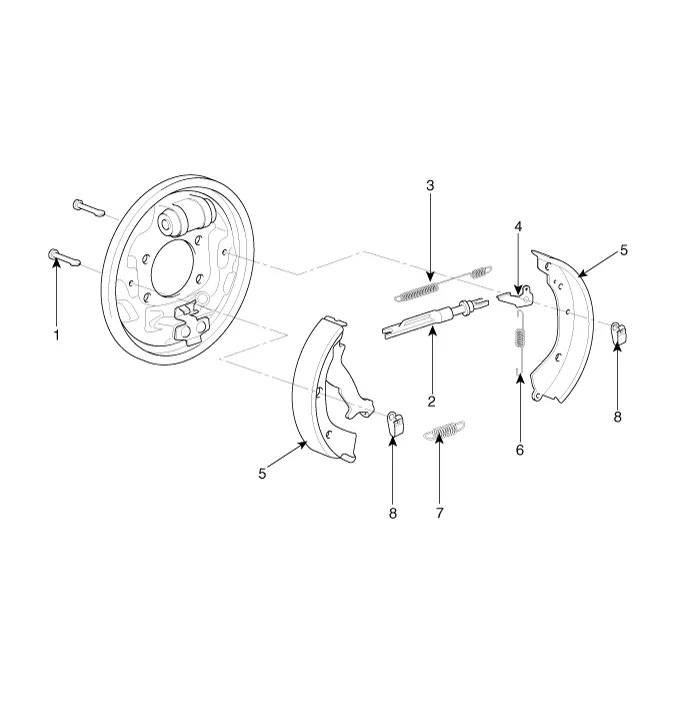Kia Picanto (JA): Brake System / Rear Drum Brake
Components and components location
| Components |

| 1. Shoe hold down pin 2. Shoe adjuster 3. Upper return spring 4. Adjusting lever | 5. Shoe 6. Adjusting spring 7. Lower return spring 8. Shoe hold spring |
Repair procedures
| Removal |
|
| 1. | Remove the rear wheel & tire.
|
| 2. | Release the parking brake. |
| 3. | Loosen the screw (B) and then remove the rear brake drum (A).
|
| 4. | Remove the lower return spring (A).
|
| 5. | Remove the upper return spring (A).
|
| 6. | Remove
the shoe hold springs (A) and shoe hold pins (B) and then remove brake
shoe (C). Make sure not to damage the dust cover on the wheel cylinder.
|
| 7. | Remove the parking brake cable (A) and then remove brake shoe (B).
|
| 8. | Remove the rear wheel speed sensor.
(Refer to ESC (Electronic Stability Control) System - "Rear Wheel Speed Sensor")
|
| 9. | Disconnect brake tubes (A) from the wheel cylinder (B).
|
| 10. | Remove the bolts (C) and the wheel cylinder (B) from the backing plate (D). |
| Installation |
|
| 1. | Apply sealant between the wheel cylinder (B) and backing plate (D), and install the wheel cylinder.
|
| 2. | Connect the brake tubes (A) to the wheel cylinder.
|
| 3. | Connect the parking brake cable (A) to the brake shoe.
|
| 4. | Install the brake shoes (C) onto the backing plate. Be careful not to damage the wheel cylinder dust covers.
|
| 5. | Install the shoe hole down pins (B) and the shoe hole down springs (A). |
| 6. | Clean
the threaded portions of adjuster sleeve (A) and push rod female (B).
Coat the threads of the adjuster assembly with grease. To shorten the
clevises, turn the adjuster bolt (C).
|
| 7. | Hook the shoe adjuster lever (C), then install it to the brake shoe.
|
| 8. | Install
the adjuster assembly (B) and upper return spring (A) as right
direction. Be careful not to damage the wheel cylinder dust covers.
|
| 9. | Install the lower return spring (B).
|
| 10. | Apply brake cylinder grease or equivalent rubber grease to the sliding surfaces shown. Don't get grease on the brake linings.
|
| 11. | Apply
brake cylinder grease or equivalent rubber grease to the brake shoe
ends and opposite edges of the shoes shown. Don't get grease on the
brake linings.
|
| 12. | Install the rear brake drum (A).
|
| 13. | If the wheel cylinder has been removed, bleed the brake system. |
| 14. | Depress the brake pedal several times to set the self-adjusting brake. |
| 15. | Adjust the parking brake. |
| Inspection |
|
|
| 1. | Raise the rear of the vehicle, and make sure it is securely supported. |
| 2. | Release the parking brake, and remove the rear brake drum. |
| 3. | Check the wheel cylinder (A) for leakage.
|
| 4. | Check the brake linings (B) for cracking, glazing, wear, and contamination. |
| 5. | Measure the brake lining thickness (C).Measurement does not include brake shoe thickness.
|
| 6. | If the brake lining thickness is less than the service limit, replace the brake shoes as a set. |
| 7. | Check the bearings in the hub unit for smooth operation. If it requires servicing, replace it. |
| 8. | Measure the inside diameter of the brake drum with inside vernier calipers.
|
| 9. | If the inside diameter of the brake drum is more than the service limit, replace the brake drum. |
| 10. | Check the brake drum for scoring, grooves, and cracks. |
| 11. | Inspect the brake lining and drum for proper contact.
|
| 12. | Inspect the wheel cylinder outside for excessive wear and damage. |
| 13. | Inspect the backing plate for wear or damage. |
Components and components location Components 1. Return spring 2. Brake pad assembly [OUT] 3. Brake pad assembly [IN] 4. Pad liner 5. Brake member 6.
Components and components location Components 1. Brake member assembly 2. Stop lamp switch 3. Brake pedal arm assembly 4. Brake pedal pad Schematic diagrams Schematic Diagram System circuit diagram Terminal function Terminal Description 1 IGN1 2 Engine Control Module (ECM) 3 B+ 4 Stop Lamp Troubleshooting Troubleshooting 1.
Other information:
Kia Picanto (JA) 2017-2025 Service & Repair Manual: Rear Washer Motor
Repair procedures Inspection 1.With the washer motor connected to the reservoir tank, fill the reservoir tank with water. Before filling the reservoir tank with water, check the filter for foreign material or contamination.
Kia Picanto (JA) 2017-2025 Service & Repair Manual: Climate Control Air Filtar
Description and operation Description This has particle filter which eliminates foreign materials and odor. The particle filter includes odor filter as well as conventional dust filter to ensure comfortable interior environment. Repair procedures Replacement 1.
Categories
- Manuals Home
- Kia Picanto Owners Manual
- Kia Picanto Service Manual
- Normal Condition
- Engine Oil and Filter
- AVN(Audio Video Navigation) head unit
- New on site
- Most important about car
















